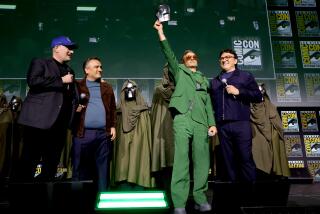DC Comics plots an end to its sales decline
- Share via
DC Comics co-publisher Dan DiDio was at a comic-book store in New Jersey when he noticed something alarming. Over the course of an hour, only two customers came in.
And, this was a Saturday — the busiest day of the week for most retailers.
“The walk-in, casual fans have gotten away from us,” DiDio observed. “We are down to just the die-hard buyers.”
Comic-book stores have become increasingly barren, with sales dropping consistently over the last three years and down an additional 7% so far in 2011.
Theories abound as to why. Some blame convoluted story lines, while others point to cynical publicity stunts like killing key characters only to bring them back a few months later. But the main culprit more likely lies beyond the page: Today’s youth is far more interested in spending its leisure hours in the digital worlds of YouTube, Xbox and Twitter.
The generational shift is not lost on DiDio and his associates at DC. For the first time, the comic-book company will now make each of its issues available on digital devices like iPads the same day it arrives in stores — a jarring departure for many retailers that only have to look at the fate of record stores to see the dangers that digital downloads present to brick-and-mortar merchants.
As part of a two-pronged strategy to try to revive its moribund business and draw newer, younger readers, the nation’s oldest and best-known comic-book publisher has also decided to start over from scratch. Beginning Aug. 31, all 52 superhero comics it publishes — including the well-known like “Wonder Woman” and “Batman” as well as more obscure titles like “Static Shock” and “Blue Beetle” — will begin again at No. 1 and feature a mix of new costumes, new origins and simplified story lines.
The strategy is a calculated risk by the Warner Bros.-owned company to keep superheroes alive in comics as they become more important than ever on the big screen and in other media.
“Publishing is the engine that creates and incubates ideas for the other divisions of Warner Bros.,” said DC co-publisher Jim Lee. “We need to streamline our comics so new fans can come in and know exactly what’s going on.”
It’s crucial to Warner that the gambit succeeds, but not because the tiny publishing business makes a big difference to the bottom line of Hollywood’s biggest studio or its corporate parent, Time Warner Inc.
Warner in 2009 reorganized its comic-book business into a new unit called DC Entertainment, headed by the studio’s former “Harry Potter” guru Diane Nelson, and moved its headquarters from New York to Burbank, down the street from the Warner lot. The move came just a few weeks after Walt Disney Co. agreed to acquire DC’s larger competitor Marvel Entertainment Inc. for $4.2 billion.
The goal for both entertainment giants is to build on the success of such superhero blockbusters as “The Dark Knight,” “Spider-Man” and “Iron Man.” Despite the failure this year of the costly “Green Lantern” movie and an aborted “Wonder Woman” television pilot, Warner has multiple DC-based movie projects in the works, including next year’s “The Dark Knight Rises” and 2013’s Superman film “Man of Steel.” There’s also a slew of planned video games releases, animated series and direct-to-DVD features.
Warner needs DC comics to stay culturally relevant and generate new ideas. At the same time, the millions of movie fans are seen as potential comic-book buyers.
“There is a generational opportunity to get new readers,” said artist Rob Liefeld, who is drawing DC’s new “Hawk and Dove” series. “The industry has been stagnant, and it’s the right time to hit the reset button.”
Some of the biggest changes are being made to DC’s 73-year-old icon Superman, and they go beyond replacing the red Speedo part of his costume with jeans. The hero will be “aged back” to his 20s, and Clark Kent’s marriage to Lois Lane, which happened 15 years ago in the comic books, has been erased.
“We want to return to that classic love triangle of Lois, Clark and Superman that people know so well,” Lee said.
More accessible stories are one part of DC’s game plan. The other is getting comics into readers’ hands. In the 1990s, there were 7,000 to 9,000 retailers that sold comic books, including newsstands and drugstores. Today there are a little more than 2,000, most of which are specialty shops.
“When I was growing up, there were three places I could walk to and get comics,” said Marv Wolfman, a veteran writer and former editor in chief of Marvel. “Today a kid might never see a comic book.”
Digital downloads are an obvious solution, but until now most publishers have only experimented with back issues online, fearful of upsetting the retailers who generate nearly all of their revenue. DC is the first to put the Internet on equal footing.
“Comics have lagged behind other media for so long in embracing digital,” said David Steinberger, chief executive of leading digital comics retailer ComiXology. “I about fell out of my chair when DC told me what they were planning.”
To salve retailers’ concerns, DiDio and Lee have gone on a “road show” around the country touting a plan to let them set up their own digital storefronts and collect 30% of revenue. Gerry Gladston, co-owner of New York-based Midtown Comics, acknowledged that there’s been plenty of angst among his fellow retailers.
“We’re not at all convinced that digital will attract a lot of new readers,” he said, “but we hope that it will drive people to our stores.”
Others, however, believe DC’s new digital strategy may mark an inflection point for an industry that will soon be paper-free.
In the short run, it seems everyone in the comic-book industry will benefit. DC’s flagship title “Justice League No. 1” has pre-orders for more than 200,000 print copies, which would make it the bestselling title of 2011. Six other new DC No. 1’s already have more than 100,000 pre-orders.
“Fan interest is huge — much of it positive, some negative, and some very cautious,” Gladston said.
But much-hyped events and reboots have boosted comic-book sales before without much long-term effect. Wolfman wrote one of the earliest in 1985 with “Crisis on Infinite Earths,” which was originally intended to result in every comic book restarting at No. 1, before editors decided against it. Since then, events, crossovers and reboots have become a near annual occurrence for DC and Marvel.
“The stunts have run their course,” Liefeld said. “This is the biggest one in the past 25 years, and nothing else can come close.”
The worst-case scenario for DC’s new strategy is that few new readers stick around and existing ones are alienated by the changes. But the relaunch’s architects said it’s a necessary risk.
“The truth is people are leaving anyway, they’re just doing it quietly, and we have been papering it over with increased prices,” DiDio said. “We didn’t want to wake up one day and find we had a bunch of $20 books that 10,000 people are buying.”
More to Read
Inside the business of entertainment
The Wide Shot brings you news, analysis and insights on everything from streaming wars to production — and what it all means for the future.
You may occasionally receive promotional content from the Los Angeles Times.









